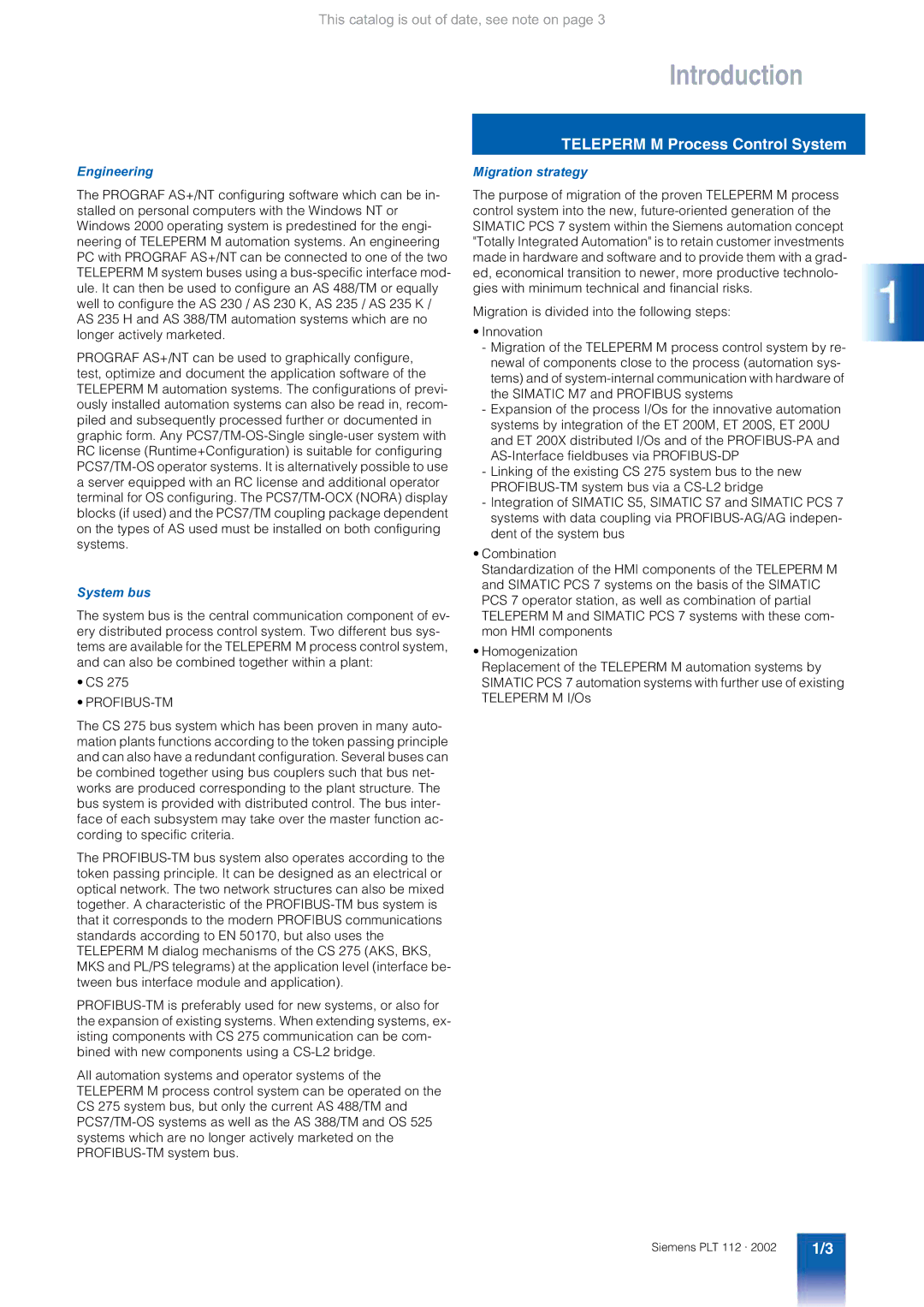Teleperm m
Related catalogs
Automation and Drives
AS 488/TM automation systems
Introduction
AS 488/TM
Teleperm M Process Control System
Overview
Introduction
Teleperm M Process Control System
Automation systems
Engineering
System bus
Migration strategy
AS 488/TM
Limitations in communication
Highlights
Classification in the Teleperm M system environment
Non-migratable systems
Area of application
Functions Highlights
System software
System architecture
System properties
Commissioning
System architecture
System properties
Functions
Technical Specifications Quantity breakdown
AS 488/TM CPU
Standard function blocks
System software
User function blocks
Optional function blocks
Blocks for analog and digital processing
Configuration
Listing of Teleperm M standard function blocks Data blocks
Blocks for binary processing
AKS
PKM
PKF
AKE
Blocks for PLC/PLC coupling with PROFIBUS-AG/AG
Type Name Function Interface
Type Name Function For modules with Order No
Blocks for I/O modules with standardized display
Organization blocks
Test blocks
Cable for connection of the commissioning terminal
Commissioning
Commissioning terminal
If 962-COM serial interface module
Engineering with Prograf AS+
Bus connection
Technical Specifications Hardware requirements
Software requirements
Automation systems released for Prograf AS+/NT
Accessories
PC components ISA for connection to Teleperm M system bus
PC components PCI for connection to Teleperm M system bus
System architecture
AS 488 S Cabinet system
AS 488 S cabinet system
AS 488 S cabinet system
Cabinet system
AS 488 S
Scope of delivery of AS 488 S systems
Connection to CS 275 system bus with versions 5 to
Power supply
Cables for connection of two I/O buses with versions 1
System software
Log IK PI
Teleperm M 19 cabinets
6DS9 207-8AA
AS 488 K Compact system
AS 488 K compact system
AS 488 K compact system
Compact system
AS 488 K
Overview Ordering Data
Teleperm M I/Os connection
Connection to CS 275 system bus
Bus components for single CS
Bus components for redundant CS
Each 6DS4 400-8AB 6DS9 203-8CA
AS 488 in Simatic design
Introduction
Technical Specifications
AS 488 in Simatic design
Introduction
ET 200U
Coupling to other systems with DP interface
Coupling to PROFIBUS-PA
ET 200B
Monitoring
Central processing unit
Overview CPU
CPU
Power supply modules
PS 405 and PS 407 load power supplies
Backup battery
If 964-DP interface module
Connection of distributed I/Os
EXM 478 expansion module 6ES7 478-2AC00-0AC0
DP2-INI initialization C79451-A3496-D900
Connection to Teleperm M I/Os
Connection to CS Connection to PROFIBUS-TM
TPM 478 interface module 6ES7 478-2DA01-0AC0
EXM 478 expansion module
Packaging system
Overview UR2 rack
Migration rack
Additional configuring tools
System software, documentation
Simatic PCS 7 cabinet design
Simatic PCS 7 cabinet design
Cabinet packaging system
Electrical design
Basic cabinet
Mechanical design
Options for the electrical design
ET 200M I/O unit
Power supply
Load power supply for I/O modules
Hot swapping
AS 488/TM system unit
Simatic PCS 7 cabinet design
Migration of existing systems
Migration packages
Migration of existing systems
Migration of existing systems
General marginal conditions
Migration packages
Scope of delivery and services
Additive supplementary components and services
AS 488 S migration package
General marginal conditions/limitations
AS 488 S migration package
AS 488 K migration package
AS 488 K migration package
GWK-PAS-AS-UPAK488
MIG I migration rack
Configuration possibilities for I/Os
MIG II migration rack
MIG K migration rack
Retrofitting services
Check list prior to retrofitting
Configuring lists
Migratable Teleperm M modules in AS 488/TM
Migratable Teleperm M modules in AS 488/TM
Binary calculation modules
Explanations for the column „Remarks
Explanations for the column „Release
Coupling modules
Migration of existing systems
Connecting PROFIBUS-PA to AS 488/TM
Process I/Os
ET 200M packaging system
Process I/Os
TBX 478 interface module 6ES7 478-2DX00-0AA0
Connecting Teleperm M I/Os
TBX 478 interface module
Set of ribbon cables C79451-A3496-D2
Connecting Simatic I/Os
Interface module for connection to PROFIBUS-DP
Communication via the PROFIBUS-DP fieldbus
COM Profibus
PROFIBUS-DP quantity breakdown
Mode of operation
DP extensions for AS 488/TM
Driver blocks
ET 200M packaging system
ET 200M
Simple packaging system with bus connectors
Components for both packaging systems
ET 200M modules
SM 323 digital input/output modules Inputs, 8 outputs
Temperature range Inputs, 16 outputs
Temperature range Inputs, 14 bit, 20 ms conver
Inputs, 8 outputs, extended
Intrinsically-safe equipment which can be connected
Ex I/O modules
Ex digital input/output modules EEx ib
Ex analog input/output modules EEx ib
Function and communications modules
ET 200S
Configuration limits when used on AS
Configuration and parameterization
ET 200S
6ES7 134-4LB00-0AB0
6ES7 134-4FB00-0AB0
6ES7 134-4FB50-0AB0
6ES7 134-4GB00-0AB0
ET 200B
ET 200X, ET 200U and ET 200B
ET 200U
IP 262 closed-loop control mod- ule
Configuration Siwa driver block
Siwarex M
Delivery forms
Connecting PROFIBUS-PA to AS 488/TM
Properties and application features of the PROFIBUS-PA
Teleperm M
Driver block Description
Connection of PROFIBUS-PA using DP/PA coupler
Connection of PROFIBUS-PA using DP/PA link
PROFIBUS-PA
IM 157 interface module for 6ES7 157-0AA81-0XA0 DP/PA link
Technical Specifications Ordering Data
Technical data DP/PA link IM DP/PA coupler Only
AS x88/TM-PA coupling soft 6DS5 130-8AA Ware, full license
Process I/Os
Bus communication
CS-L2 bridge
Bus communication
Transmission systems
Bus connector
Electrical bus terminal
Optical link module
Optical bus terminal OBT for Profibus
Transmission media
Configuring
TPM 478 interface module
In-house remote bus cable
Standard remote bus cable V45466-D21-B35
Length ..... m
Remote bus cable with addi- tional armoring
CS-L2 bridge
CS-L2 bridge
CS-L2 bridge
Configuration Station addresses
Performance data
PROFIBUS-TM
Central processing unit
PS 405 load power supply, 10 a 6ES7 405-0KA01-0AA0
Connection to PROFIBUS-TM Connection to CS
If 964-DP interface module 6ES7 964-2AA01-0AB0
TPM 478 interface module
Ordering Data Overview
Data couplings with other systems
Introduction AG-AG coupling software Serial coupling
10/2
Data couplings with other systems
Data couplings
Coupling with systems from other vendors
10/3
System couplings
AG-AG coupling software
AG/AG coupling with Simatic S5/S7 central controllers
AG/AG coupling software 6DS5 124-1AA
10/4
PROFIBUS-AG/AG
SDA
10/5
Direct couplings
Serial coupling
Transmission rate Max. cable length
10/6
Appendix
Software
Appendix
Software licenses
11/2
Information and order option
Internet and on CD-ROM
11/3
Internet
Internet, Training
11/4
Training Courses in the Training Center Karlsruhe
Order No. index
11/5

